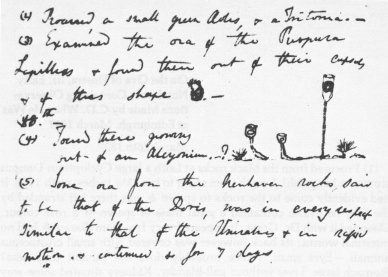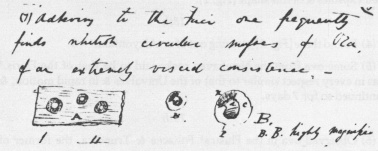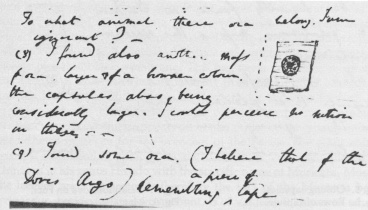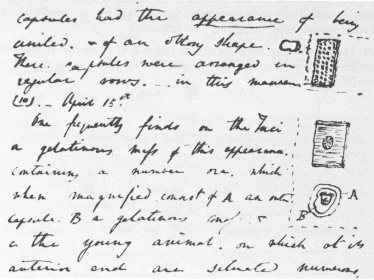[page] 285
On the Ova of Flustra, or, Early Notebook, Containing Observations Made by CD. When He Was at Edinburgh, March 18271
March 16th 1827
(1) Procured from the black rocks at Leith a large Cyclopterus Lumpus (common lump fish). Length from snout to tail 23 1/2 inches, girth 191/2. It had evidently come to the rocks to spawn & was there left stranded by the tide; its ovaria contained a great mass of spawn of a rose colour. Dissected it with Dr. Grant. It appeared very free from disease & had no intestinal worms; its back however was covered with small crustaceous animals.—Eyes small. Hence probably does not inhabit deep seas? Stomach large. Liver without gall-bladder. Kidneys situated some way from the Vertebrae: an unusual fact in cartilaginous Fishes. Air bladder was not seen. Brain very small; the optic nerves being nearly as large as the spinal cord, neither the brain or spinal matter nearly filling its cavity. The valves in the heart were very distinct; the peduncle strong. The body was not covered with <skin> [?]2 scales, but slimy & remarkably thick. The sucker on its breast was of a white colour. I believe it is generally a reddish yellow? The plebs differ whether it is edible.
(2) Procured a small green Aeolis3 & a Tritonia.4
(3) Examined the ova of the Purpura Lapillus5 & found them out of their capsules & of this shape [Fig. 1].
18th
(4) Found these [Fig. 2] growing out of an Alcyonium.6—?
(5) Some ova from the Newhaven rocks said to be that of the Doris,7 was in every respect similar to that of the Univalves & in rapid motion, & continued so for 7 days.
19th
(6) Observed ova in the Flustra8 Foliacea & Truncata, the former of
which were in motion.
28th
(7) Adhering to the Fuci9 one frequently finds whitish circular masses
[page] 286

Fig. 1. Ova of Pupura Lapillus. Fig. 2. Growths of Alcyonioum.
of Ova, of an extremely viscid consistence,—& have the appearance represented at A [Fig. 3], when magnified however, it appears to be a mass [of] capsules P10 containing animals d united together by a transparent gelatinous matter. In this species I believe I was the first to observe both the animal d, & its ciliae, x, in most rapid movement. By

Fig. 3. Ova adhering to Fuci.
[page] 287
the aid of these ciliae it could revolve in its capsule & when freed from it moved so quickly, as to be discernible to the naked eye at some distance. To what animal these ova belong. I am ignorant?
(8) I found also another mass of ova, larger & of a browner colour, the capsules also being considerably larger. I could perceive no motion in these [Fig. 4].

Fig. 4. Mass of brown ova.
(9) Found some ova (I believe that of the Doris Argo) resembling a piece
of tape.—the capsules were rather irregular, containing from 1 to 3
angular shaped bodies.—in which I could perceive no motion.—the
capsules had the appearance of being united, & of an oblong shape [Fig.
5]. These capsules were arranged in regular rows—in this manner [Fig.
6].
April 15th
(10) One frequently finds on the Fuci a gelatinous mass of this appear
ance [Fig. 7] containing a number [of] ova, which when magnified consist
of A [Fig. 8], an outer capsule B a gelatinous mass, &c the young animal on
which at its anterior end are situated numerous ciliae. These by their
constant motion cause the young animal to turn rapidly round within the
capsule,—& when freed from its capsule to move to & fro in the water
with the greatest ease. I kept some of these ova in a bottle of the same
water & at the end of 30 days were yet in motion.—
[page] 288

Fig. 5. Oblong capsules. Fig. 7. Gelatinous ova on Fuci.
Fig. 6. Rows of capsules. Fig. 8. Magnified ova.
20th
(11) Having procured some specimens of the Flustra Carbocea (Lam.) from the dredge boats at Newhaven, I soon perceived without the aid of a microscope small yellow bodies studded in different directions on it. They were of an oval shape & of the colour of the yolk of an egg, each occupying one cell. Whilst in their cells I could perceive no motion: but when left at rest in a watch glass, or shaken they glided to & fro with so rapid a motion, as at some distance to be distinctly visible to the naked eye. When highly magnified, the ciliae, which were chiefly distributed on the broader end, were seen in rapid motion; the central ones being the longest. I may mention that I have also observed ova of the Flustra Foliacea & Truncata in motion. That such ova had organs of motion does not appear to have been hitherto observed either by Lamarck Cuvier Lamouroux or any other author. This fact although at first it may appear of little importance, yet by adducing one more to the already numerous examples will tend to generalise the law that the ova of all Zoophites enjoy spontaneous motion.
[page] 289
This & the following communication was read both before the Wernerian & Plinian Societies.
(12) One frequently finds sticking to oyster & other old shells small black globular bodies, which the fishermen call great Pepper-corns. These have hitherto been always mistaken for the young Fucus Lorius to which it bears a great resemblance. Having opened some of these they at first appeared only to contain an extremely viscid fluid without any traces [of] organisation; but on examining some others I found that this fluid by degrees acquiring a vermicular shape, when matured was the young Pontobdella11 Muricata (Lam.) which were in every respect perfect & in motion. Each ovum consisted of two parts, the outer capsule being cori[a]ceous & of considerable thickness, whilst the inner consisted merely of a thin black membrane. This bag never contained more than one animal, in which it differs remarkably from that of other Molluscous animals such as the Doris Buccinum Purpura &c. &c., for in these one capsule generally contains numerous ova. At each end there is a prominent orifice, which appears to be the outlet of the young animal, but hitherto mistaken for the branches of the Fucus. The adult animal bears a considerable analogy to the Leeches & was even placed by Linnaeus in his genus Hirudo with the specific name of Muricata. Most of the leeches are viviparous & therefore the fact of the Muricata being oviparous, besides on its own account, is of value as it shows to what a great extent the mode of generation differs in the lower animals.
(13) Procured on 15th of April from deep water in Frith of Forth a good many specimens of the Pennatula12 Mirabilis. The Polype were situated on one side of the bony axis in alternate lunate fillets in number from 70-80. Each fillet consisted of about 12 polype. Towards one end of many of the longest specimens a yellowish appearance, which upon examination turned out to be numerous ova. They were situated between the fillets towards the bare side of the stem. They were easily separated in great number from the gelatinous axis upon its being torn. But I could perceive no motion.
23rd
(14) Procured from the Frith of Forth numerous specimens of the Pennatula Phosphorea. differs from the Mirabilis in there being only 20 rows or Fillets of polype, & in these rows about 12 Polype. These fillets are opposite & decrease in size towards both end of the axis. The bony axis does not appear at either end of the Zoophite as it does in the Mirabilis, but gradually tapers into two filiform soft & flexible points embedded in the fleshy matter. Inclosed in & at the base of the fillets were
[page] 290
several ova of a large size & of a yellow colour could perceive no motion. I may remark that each fillet is broardest in the middle & tapers toward both ends. The whole Zoophite has a soft <glu> slimy feel, & of a red colour. The long axis in both of the above-mentioned species effervesced rapidly with nitric acid.
(15) Observed, with Mr. Coldstream at the black rocks at Leith, an Asterias13 rubens doubled up as it were, so that the disk part formed pouch, in which were numerous loose ova, which the animal was in act of discharging from its mouth. The double Ovaria in each of the animals limbs contained a mass of ova of a small size & of an orange colour.
(16) Having taken a grain of pollen out of the Anther in an unopened Geranium flower: I placed it in spirits of wine: it was of a spherical shape & of a yellow colour: after remaining a minute in the Spirits three transparent cones were protruded from its side: these in the course of a few minutes burst, & sent, with great violence, from one of the cones numberless granules: By the next morning (the Geranium being kept in water) the Anthers had deshisced & the pollen was scattered about. A grain now being placed in <water> Spirits, emitted its contents with such force that the grain itself moved very rapidly in the liquid so rapidly indeed, that I could not follow with the microscope: When placed in water it exploded almost instantly but not with quite such force.
The Epidermis of the Petals in the Geranium is very curious; it consists of 6 (or occasionally 7) sided cells) on the sides of these cells; these [had] 12 small projections which alternate with those of the neighbouring cells: it has the same appearance, both on upper & under side: no stomata: In the Stamina, the cuticle [cells] of the Filament were Rhomboidal: in the covering of the Antherii the cells had knobbed sides: The pistil full of Tracheae. Cuticle with Rhomboidal cells. Sepals full of Tracheae. Cuticle with oblong cells. The cells in the cuticle of the Bracteae very irregular oblong: in the Pedicel rather more regular:—A Transverse section of this latter part gives a star-like appearance, this is owing to about 10 groups of ducts set within a ring of them: by dissecting a portion of the pedicel vertically these ducts were very easily seen: without this darkish ring came a circle of rather irregularly celled parenchymatous matter: then ring of green matter: then cuticle.—Examined the grain of pollen in Orchis morio. they are of a green colour & of a wedge shape with the sharp end truncated. They are fastened at their narrow ends one to the other by a highly elastic thread.—
1. Cambridge University Library Handlist (1960) no. 118. Acknowledgment is due the Cambridge University Library for microfilm copies and for permission to publish this transcription. Parts of this paper were transcribed and published by J. H. Ashworth in "Charles Darwin as a Student in Edinburgh, 1825-1827," Proceedings of the Royal Society of Edinburgh, 55 (1934-35): 97-113.
[page] 291
Accounts differ on the exact time, place, and subject of the paper's presentation. In the paper Darwin says (page 289), "This & the following communication was read both before the Wernerian & Plinian Societies." In his autobiography (written in his sixty-seventh year) he says, "I made one interesting little discovery, and read, about the beginning of the year 1826, a short paper on the subject before the Plinian Society. This was that the so-called ova of Flustra had the power of independent movement by means of cilia, and were in fact larvae. In another short paper I showed that the little globular bodies which had been supposed to be the young state of Fucus loreus were the egg-cases of the wormlike Pontobdella muricata." The "minute-book" records of the Plinian Natural History Society (now in the Edinburgh University Library) show that on 27 March 1827 "Mr. Darwin communicated to the Society two discoveries which he had made:
1. That the ova of the Flustra possess organs of motion.
2. That the small black globular body hitherto mistaken for the young Fucus lorius is in reality the ovum of the Pontobdella muricata." (Ashworth, ibid., p. 103).
Some of the notes in the paper are dated 15 April or later, suggesting this manuscript was not the copy used by Darwin for his presentation. Possibly it was used at a later meeting not recorded in the "minute-book." Ashworth provides a more complete discussion of historical circumstances surrounding this paper.†
2. The word skin seems to have been written in, then lightly crossed through. Note: angular brackets enclose words crossed through in the original manuscript.†
3. Aeolis: anudibranchiate mollusk.†
4. Tritonia: Gastropoda.†
5. Purpura lapillus: Grostropoda.†
6. Alcyonium: an Actinozoa of the Coelenterata.†
7. Doris: an udibranchiate mollusk.†
8. Flustra: a Bryozoan.†
9. Fucus: brown algae; Fucaceae.†
10. Probably should be "B." Darwin in haste perhaps added "P" to the drawing, after inadvertently saying "P" in the text.†
11. Pontobdella: Hirudinea.†
12. Pennatula: sea pen; Pennatulidae of the Actinozoa.†
13. Asterias: a starfish.†